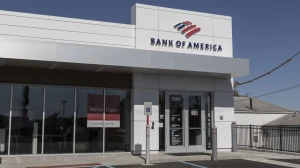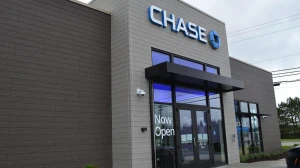
Largest Banks in the US, What Are the Top Banks in US?
The 15 largest banks in the U.S., collectively holding around $12.9 trillion in assets, are led by JPMorgan Chase with $3.39 trillion, shaping the nation's financial landscape through extensive branch networks and diverse financial services.
by Kowsalya
Published Aug 11, 2023 | Updated Dec 30, 2023 | 📖 5 min read
Largest Banks in the U.S
The 15 largest banks in the U.S. collectively hold around $12.9 trillion in assets. JPMorgan Chase leads the list with $3.39 trillion in assets, followed by Bank of America and Wells Fargo. Changes in rankings may occur due to mergers, acquisitions, or bank failures, influencing the dynamics of this exclusive club.
|
Rank |
Bank Name |
|
1 |
JPMorgan Chase |
|
2 |
Bank of America |
|
3 |
Wells Fargo |
|
4 |
Citigroup |
|
5 |
U.S. Bancorp |
|
6 |
PNC Financial Services |
|
7 |
Goldman Sachs |
|
8 |
Truist Financial |
|
9 |
Capital One Financial |
|
10 |
TD Group Holdings |
|
11 |
Bank of New York Mellon |
|
12 |
State Street |
|
13 |
BMO |
|
14 |
Citizens Financial |
|
15 |
First Citizens Bank |
JPMorgan Chase
JPMorgan Chase, with assets totaling $3.39 trillion, holds the top position among the largest banks in the U.S. Headquartered in New York, Chase Bank, its consumer banking division, boasts more than 4,700 branches and over 16,000 ATMs, making it a key player in the financial landscape.
Bank of America
Securing the second spot is Bank of America, with assets valued at $2.47 trillion. Serving approximately 68 million consumers and small business clients globally, Bank of America, headquartered in Charlotte, North Carolina, is recognized for its robust digital tools, including a versatile mobile app.
Wells Fargo
Founded in 1852, Wells Fargo claims the third position, with assets amounting to $1.70 trillion. The San Francisco-based bank has undergone rebranding efforts and introduced innovative apps, targeting millennials. Despite a series of missteps, Wells Fargo remains a significant player in the U.S. banking sector.
Citigroup
Global financial services corporation Citigroup holds the fourth position with $1.66 trillion in assets. Operating in over 673 locations in the U.S. and 1,800 branches internationally, Citigroup, headquartered in New York, provides a wide range of financial services. U.S. customers can access more than 65,000 fee-free ATMs.
U.S. Bancorp
U.S. Bancorp, the fifth-largest commercial bank by assets, boasts $657.2 billion. Originating as the First National Bank of Cincinnati in 1863, it has evolved into a prominent player with branches in over half of the 50 states. The Minneapolis-based bank focuses on enhancing its digital offerings to meet evolving consumer needs.
PNC Financial Services
Founded in 1852, PNC Financial Services holds the sixth position with $553.1 billion in assets. With around 2,570 locations in 28 states and Washington, D.C., PNC's size doubled with the acquisition of BBVA USA for $11.6 billion in 2021.
Goldman Sachs
As a global investment banking, management, and securities firm, Goldman Sachs secures the seventh position with assets totaling $538.1 billion. Offering a range of financial services, including Marcus, its online banking arm, Goldman Sachs has a significant presence in the financial industry.
Truist Financial
Truist Financial, formed by the merger of BB&T and SunTrust, ranks eighth with $535 billion in assets. Serving about 12 million consumer households, Truist Bank, headquartered in Charlotte, North Carolina, emerged from the union of two banks with a combined history of around 275 years.
Capital One Financial
Fortune 500 company Capital One Financial claims the ninth spot, boasting assets of $468.8 billion. With branches on the East Coast, Texas, and Louisiana, Capital One offers unique customer experiences through Capital One Cafés, providing free Wi-Fi, financial workshops, and account-opening services.
TD Group Holdings
TD Bank, the U.S. commercial banking arm of Canada's TD Bank Group, holds the tenth position with assets of $366.3 billion. With more than 1,100 branches along the East Coast and access to around 2,600 branches, TD Bank caters to a diverse range of customers with offerings like mortgages, credit cards, and commercial banking services.
Bank of New York Mellon
Bank of New York Mellon, with assets totaling $328.5 billion, occupies the eleventh position. Dating back to the opening of the New York Stock Exchange in 1792, the bank has transformed into an investment company providing services to corporations, institutions, and individual investors.
State Street
Founded in 1792, State Street Corp. secures the twelfth position with assets amounting to $280.5 billion. Functioning as a financial services and asset management company with a global presence, State Street caters to a diverse clientele, including asset owners, insurance companies, and pension funds.
BMO
Bank of Montreal (BMO), with more than 500 branches in the U.S., ranks thirteenth with assets of $260.8 billion. Operating in several states, including Arizona, Illinois, and Florida, BMO offers a range of financial services to its customers.
Citizens Financial
Citizens Financial, occupying the fourteenth spot, has assets totaling $225 billion. With around 1,200 branches in 14 states, Citizens Financial provides a suite of retail, small business, and commercial banking products. Notably, it closed a deal to acquire HSBC branches in February 2022.
First Citizens Bank
First Citizens Bank, with a history spanning 125 years, holds the fifteenth position with assets amounting to $213.6 billion. Following a merger with CIT Bank in early 2022, First Citizens Bank continues to be a significant player in the U.S. banking sector.
Which Bank Has the Most Branches?
JPMorgan Chase not only stands as the largest bank in the U.S. based on total assets but also holds the distinction of having the most extensive domestic branch network. With over 4,700 branches spanning across the lower 48 states, Chase has a significant physical presence.
This widespread branch network ensures accessibility for customers across the nation. Wells Fargo and Bank of America closely trail behind, with over 4,600 and 3,800 branches, respectively. The vast reach of these banks contributes to their popularity and convenience for a wide array of customers.
Whether you're a seasoned investor or just starting, MarketsHost remains your ultimate destination for comprehensive information, profound insights, and expert guidance within the realm of Finance.
What is the Most Popular Bank?
Among the 10 largest banking institutions, several emerge as the most popular choices, varying by state and influenced by factors such as branch and ATM accessibility, reputation, and recognizability. Wells Fargo, Chase, Bank of America, and U.S. Bank consistently rank among the top choices for consumers.
The popularity of these banks is not only attributed to their widespread presence and convenience but also to the trust and recognition they have garnered over the years. In certain regions, smaller, regional banks may also gain popularity due to their localized and more convenient branch networks.
Largest Banks in the US-FAQs
1. Should you choose one of the largest banks in the U.S.?
Consider a large bank for extensive services, but evaluate based on your specific financial needs and preferences.
2. Are large banks safer than small banks?
Safety depends on factors like regulations; both large and small banks can be secure if well-regulated.
3. Can you provide recent examples of banks merging or being acquired that affected the list of largest banks?
Certainly, recent examples include JPMorgan Chase's acquisition of First Republic Bank's deposits and assets, as well as the merger of BB&T and SunTrust to form Truist Bank, impacting the rankings.
4. What are the drawbacks of big banks?
Potential drawbacks include higher fees, less personalized service, and a more bureaucratic approach.
5. What are the top five banks in America?
JPMorgan Chase, Bank of America, Wells Fargo, Citigroup, and U.S. Bancorp are among the top five largest banks in the U.S.




